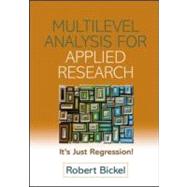
| Broadening the Scope of Regression Analysis | |
| Chapter Introduction | |
| Why Use Multilevel Regression Analysis? | |
| Limitations of Available Instructional Material | |
| Multilevel Regression Analysis in Suggestive Historical Context | |
| It's Just Regression under Specific Circumstances | |
| Jumping the Gun to a Multilevel Illustration | |
| Summing Up | |
| Useful Resources | |
| The Meaning of Nesting | |
| Chapter Introduction | |
| Nesting Illustrated: School Achievement and Neighborhood Quality | |
| Nesting Illustrated: Comparing Public and Private Schools | |
| Cautionary Comment on Residuals in Multilevel Analysis | |
| Nesting and Correlated Residuals | |
| Nesting and Effective Sample Size | |
| Summing Up | |
| Useful Resources | |
| Contextual Variables | |
| Chapter Introduction | |
| Contextual Variables and Analytical Opportunities | |
| Contextual Variables and Independent Observations | |
| Contextual Variables and Independent Observations: A Nine-Category Dummy Variable | |
| Contextual Variables, Intraclass Correlation, and Misspecification | |
| Contextual Variables and Varying Parameter Estimates | |
| Contextual Variables and Covariance Structure | |
| Contextual Variables and Degrees of Freedom | |
| Summing Up | |
| Useful Resources | |
| From OLS to Random Coefficient to Multilevel Regression | |
| Chapter Introduction | |
| Simple Regression Equation | |
| Simple Regression with an Individual-Level Variable | |
| Multiple Regression: Adding a Contextual Variable | |
| Nesting (Again!) with a Contextual Variable | |
| Is There a Problem with Degrees of Freedom? | |
| Is There a Problem with Dependent Observations? | |
| Alternatives to OLS Estimatorspt; FONT-FAMILY: Arial; mso-bidi-font-weight: bold" | |
| The Conceptual Basis of ML Estimators | |
| Desirable Properties of REML Estimators | |
| Applying REML Estimators with Random Coefficient Regression Models | |
| Fixed Components and Random Components | |
| Interpreting Random Coefficients: Developing a Cautionary Comment | |
| Subscript Conventions | |
| Percentage of Variance Explained for Random Coefficient and Multilevel Models | |
| Grand-Mean Centering | |
| Grand-Mean Centering, Group-Mean Centering, and Raw Scores Compared | |
| Summing Up | |
| Useful Resources | |
| Developing the Multilevel Regression Model | |
| Chapter Introduction | |
| From Random Coefficient Regression to Multilevel Regression | |
| Equations for a Random Intercept and Random Slope | |
| Subscript Conventions for Two-Level Models: Gamma Coefficients | |
| The Full Equation | |
| AnImpliedCross-Level Interaction Term | |
| Estimating a Multilevel Model: The Full Equation | |
| A Multilevel Model with a Random Slope and Fixed Slopes at Level One | |
| Complexity and Confusion: Too Many Random Components | |
| Interpreting Multilevel Regression Equations | |
| Comparing Interpretations of Alternative Specifications | |
| What Happened to the Error Term? | |
| Summing Up | |
| Useful Resources | |
| Giving OLS Regression Its Due | |
| Chapter Introduction | |
| An Extended Exercise with County-Level Data | |
| Tentative Specification of an OLS Regression Model | |
| Preliminary Regression Results | |
| Surprise Results and Possible Violation of OLS Assumptions | |
| Curvilinear Relationships:YBUSH byXBLACK,XHISPANIC,XNATIVE | |
| Quadratic Functional Form | |
| A Respecified OLS Regression Model | |
| Interpreting Quadratic Relationships | |
| Nonadditivity and Interaction Terms | |
| Further Respecification of the Regression Model | |
| Clarifying OLS Interaction Effects | |
| Results for the Respecified OLS Regression Equation for County-Level Data | |
| Summing Up | |
| Useful Resources | |
| Does Multilevel Regression Have Anything to Contribute? | |
| Chapt | |
| Table of Contents provided by Publisher. All Rights Reserved. |
The New copy of this book will include any supplemental materials advertised. Please check the title of the book to determine if it should include any access cards, study guides, lab manuals, CDs, etc.
The Used, Rental and eBook copies of this book are not guaranteed to include any supplemental materials. Typically, only the book itself is included. This is true even if the title states it includes any access cards, study guides, lab manuals, CDs, etc.